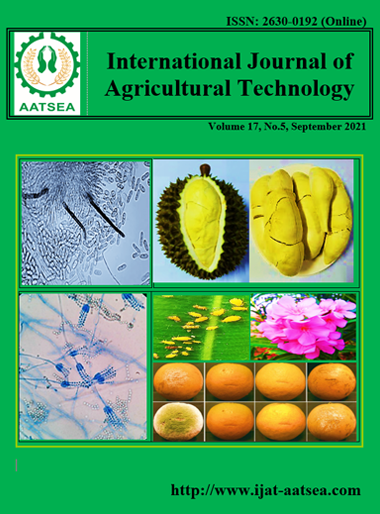Water quality factors related to phytoplankton population changes in the estuary ecosystem: a case study of Mae Klong estuary and Tha Chin estuary, upper Gulf of Thailand
Main Article Content
Abstract
The water quality impacts on phytoplankton dynamics in the 3 seasons: winter (January), summer (April) and rainy (September). The total ammonia in the rainy season was significantly higher than in other seasons (p < 0.05) , the BOD value is significantly higher than other seasons (p < 0.05). All four groups of plankton were found, namely blue-green algae, green algae, diatoms, and dinoflagellate, with a total of 40 species. After analysis of the correlation coefficient between the average density of the blue-green algae and the water quality factors showed a high level of correlation (r = 0.7 - 0.9) with pH (r = 0.899) and BOD (r = 0.818), but high concentration of total ammonia (r = -0.875) had high level in opposite direction, the diatomic group showed a high level of correlation with the salinity of water (r = 0.879) and total hardness (r = 0.944), and the dinoflagellate had a high level of correlation with the total ammonia (r = 0.761) were statistical significance (p < 0.05). It can be concluded that the water quality factors varied in each season which are related to the changes in the quantity of prominent phytoplankton. It proved that in the winter season during the water had high salinity and hardness that found a lot of the diatomic group. While in the rainy season with low salinity but high concentration of total ammonia, found a lot of the dinoflagellate. The blue-green algae positively correlated with BOD value and had a negative relationship with high concentration of total ammonia. Therefore, in the summer which had high ammonia, a lot of blue-green algae are found, but in the rainy season with a high concentration of total ammonia, a small amount of blue-green algae were found
Article Details

This work is licensed under a Creative Commons Attribution-NonCommercial-NoDerivatives 4.0 International License.
References
ACFS (2016). Guidance on the application of Thai agricultural standard, good aquaculture practices for freshwater animal farm. Ministry of Agriculture and Cooperatives, Bangkok.
APHA, AWWA and WEF (2012). Standard methods for examination of water and wastewater. (twenty-second edition), Washington, American Public Health Association.
Batley, G. E. and Simpson, S. L. (2009). Development of guidelines for ammonia in estuarine and marine water systems. Marine Pollution Bulletin, 58:1472-1476.
Battish, S. K. (1992). Freshwater zooplanktons of India. Oxford and IBH publishing co. Ltd., New Delhi.
Bhatnagar, A. and Devi, P. (2013). Water quality guidelines for the management of pond fish culture. International Journal of Environmental Sciences, 3:1980-2009.
Chowdhury, M. M. R., Shahjahan, M., Rahman, M. S. and Sadiqul, I. M. (2008). Duckweed (Lemna minor) as supplementary feed in monoculture of Nile tilapia, Oreochromis niloticus. Journal of Fisheries and Aquatic Sciences, 3:54-59.
Eddy, F. B. (2005). Ammonia in estuaries and effects on fish. Journal of Fish Biology, 67:1495-1513.
Evens, T. J., Kirkpatrick, G. J., Millie, D. F., Chapman, D. J. and Schofield, O. M. E. (2001). Photophysiological responses of the toxic red-tide dinoflagellate Gymnodinium breve (Dinophyceae) under natural sunlight. Journal of Plankton Research, 23:1177-1193.
Gupta, C., Prakash, D. and Gupta, S. (2015). Role of blue green algae in environment management. Environmental Microbiology, pp.22-44.
Haddouta, S. S., Maslouhia, A., Magraneb, B. and Igouzala, M. (2015). Study of salinity variation in the Sebou River Estuary (Morocco). Desalination and Water Treatment. Balaban Desalination Publications, Morocco, pp.1-12.
Hopkinson, C. J., Smith, E. M., del Giorgio, P. A. and Williams, P. J. le B. (2005). Estuarine respiration: an overview of benthic, pelagic and whole system respiration, In: del Giorgio, P. A. and Williams, P. J. le B. ed. Respiration in Aquatic Ecosystems, Oxford University Press, New York.
Jackson, J. B. C., Kirby, M. X. and Berger, W. H. (2001). Historical overfishing and recent collapse of coastal ecosystems. Science, 293:629-638.
Krebs, C. J. (2001). Ecology: The experimental analysis of distribution and abundance. (fifth edition), Benjamin Cummings, San Francisco.
Masmoudi, S., Tastard, E., Guermazi, W., Caruso, A., Manceau, M. A. and Ayadi, H. (2015). Salinity gradient and nutrients as major structuring factors of the phytoplankton communities in salt marshes. Aquatic Ecology, 49:1-19.
Meksumpun, S. (2002). Physiology of Marine Phytoplankton, Department of Marine Science, Faculty of Fisheries, Kasetsart University, Bangkok, Thailand.
Nixon, S. W. (1995). Coastal marine eutrophication: a definition, social causes, and future concerns. Ophelia, 41:199-219.
Siddika, F. (2012). Abundance of plankton population densities in relation to bottom soil textural types in aquaculture ponds. International Journal of Agricultural Research, Innovation and Technology, 2:56-61.
Tang, B., Liu, B., Wang, G., Zhang, T. and Xiang, J. (2006). Effects of various algal diets and starvation on larval growth and survival of Meretrix meretrix. Aquaculture, 254:256-533.
Trigueros, J. M. and Orive, E. (2001). Seasonal variations of diatoms and dinoflagellates in a shallow, temperate estuary, with emphasis on neritic assemblages. Hydrobiologia, 444: 119-133.
Tucker, C. S. (2000). Off-flavor problems in aquaculture. Reviews in Fisheries Science, 8:45-88.
Wang, D. Z. (2008). Neurotoxins from marine dinoflagellates: A brief review. Marine Drugs, 6:349-371.
Wu, M. L., Wang, Y. S., Yu-Tu, W., Sun, F. L., Sun, C. C., Jiang, Z. Y. and Cheng, H. (2014). Influence of environmental changes on phytoplankton pattern in Daya Bay, South China Sea. Revista de Biología Marina y Oceanografía, 49:323-337.
Saeiam, Y., Pichitkul, P., Nedtharnn, U. and Wudtisin, I. (2020) Phytoplankton community dynamics and its impacts on the quality of water and sediments in the recirculated-water earthen pond system for hybrid red tilapia (Oreochromis niloticus x mossambicus) farming. International Journal of Agricultural Technology, 16:695-710.
Zhuang, S. H. and Wang, Z. Q. (2004). Influence of size, habitat and food concentration on the feeding ecology of the Bivalve, Meretrix meretrix Linnaeus. Aquaculture, 241:689-69.


